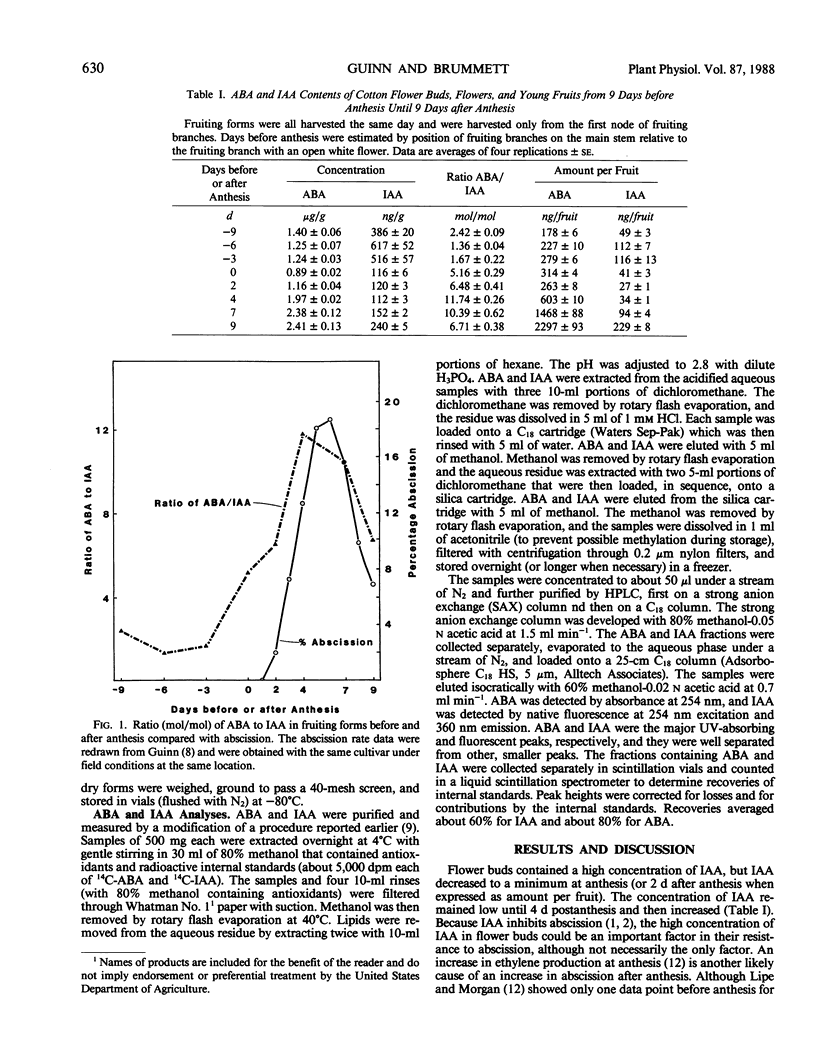Abstract
Cotton (Gossypium hirsutum L.) fruiting forms exhibit pronounced changes, with age, in their probability of abscission. Large floral buds rarely abscise, but after anthesis the young fruits (bolls) have a high probability of abscising. Abscission rate reaches a peak about 5 to 6 days after anthesis and then gradually decreases. An experiment was conducted to try to determine the reason for the rapid and pronounced increase in probability of abscission just after anthesis. Cotton was grown in the field and fruiting forms of various ages from 9 days before to 9 days after anthesis were all harvested the same day and subsequently analyzed for ABA and IAA. The concentration of ABA decreased slightly at anthesis and increased gradually thereafter. In contrast, the concentration of IAA was high before anthesis and then decreased at anthesis to about one-fifth the previous concentration. IAA remained low for at least 4 days after anthesis and then increased rapidly between 7 and 9 days after anthesis. The high concentration of IAA in floral buds before anthesis is probably a major factor in their resistance to abscission. Likewise, the low concentration of IAA at anthesis and for about 4 days thereafter may promote fruit abscission during the young boll stage.
Full text
PDF


Selected References
These references are in PubMed. This may not be the complete list of references from this article.
- Davis L. A., Addicott F. T. Abscisic Acid: correlations with abscission and with development in the cotton fruit. Plant Physiol. 1972 Apr;49(4):644–648. doi: 10.1104/pp.49.4.644. [DOI] [PMC free article] [PubMed] [Google Scholar]
- Eaton F. M., Ergle D. R. Relationship of Seasonal Trends in Carbohydrate and Nitrogen Levels and Effects of Girdling and Spraying with Sucrose and Urea to the Nutritional Interpretation of Boll Shedding in Cotton. Plant Physiol. 1953 Jul;28(3):503–520. doi: 10.1104/pp.28.3.503. [DOI] [PMC free article] [PubMed] [Google Scholar]
- Guinn G., Brummett D. L., Beier R. C. Purification and measurement of abscisic Acid and indoleacetic Acid by high performance liquid chromatography. Plant Physiol. 1986 Aug;81(4):997–1002. doi: 10.1104/pp.81.4.997. [DOI] [PMC free article] [PubMed] [Google Scholar]
- Guinn G. Fruit age and changes in abscisic Acid content, ethylene production, and abscission rate of cotton fruits. Plant Physiol. 1982 Feb;69(2):349–352. doi: 10.1104/pp.69.2.349. [DOI] [PMC free article] [PubMed] [Google Scholar]
- Lipe J. A., Morgan P. W. Ethylene: role in fruit abscission and dehiscence processes. Plant Physiol. 1972 Dec;50(6):759–764. doi: 10.1104/pp.50.6.759. [DOI] [PMC free article] [PubMed] [Google Scholar]


